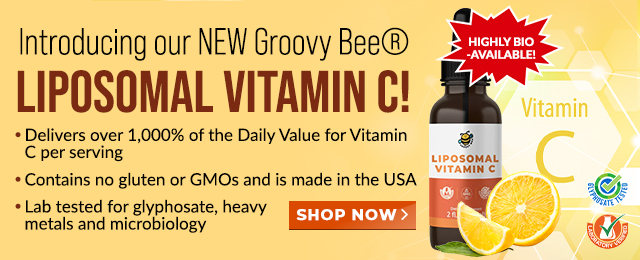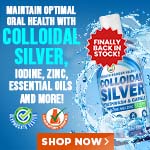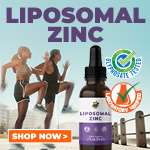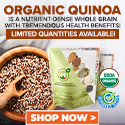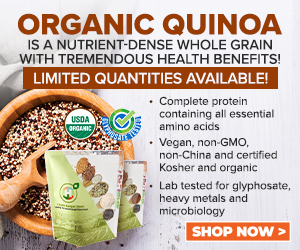
Increase Complete Protein and Lose Weight
Wednesday, March 25, 2009 by: Barbara L. Minton
Tags: proteins, health news, Natural News
- CLOT SHOT PLANDEMIC UNFOLDING: Fibrous, rubbery clots caused by covid injections have prion-like seeding activity
- Widespread social and economic unrest: Steve Quayle issues urgent financial warning of imminent asset collapse in new interview with Mike Adams
- DEATH by VACCINE or face PRISON time: Canadian Freedom Convoy leaders CONVICTED for protesting forced vaccination during the Covid Plandemic
- How to detox from metals falling out of the sky
- Aerosolized bioweapons? Strange “diploid biomasses” falling out of the sky in Florida captured under the microscope
- How Israeli military-connected corporations are secretly controlling your online privacy
- How the peanut allergy epidemic was fueled by faulty science and institutional arrogance
- “Rockefeller Medicine Men”: Today’s healthcare crisis stems from the creation of the American medical establishment
- Analysis: The coming economic collapse, a mass uprising and Trump's three secret weapons to halt the growing revolt
- Thimerosal is 50 percent MERCURY and NO it has NOT been removed from vaccines - that was a BIG FAT LIE the CDC told vax skeptics to keep them vaxxed up and dying
- Kiss Your Genetic Privacy Good-Bye! 23andMe Gets Green Light to Sell Your Intimate Genetic Details to Anyone They Want
- Mike Adams releases country western hit single: Goin’ Back in Time is Comin’ Home
- Global financial Ponzi scheme collapses in real time as markets plummet, Mike Adams and Steve Quayle warn of impending chaos
- EU takes aim at Elon Musk's X with potential $1 billion fine under Digital Services Act
- Defunding DEADLY mRNA jabs: Government funding for mRNA technology being scrutinized and sidelined until proven "safe and effective" for real
- European Court of Justice: Healthcare professionals who promoted or administered COVID-19 vaccines are CRIMINALLY LIABLE for any harm caused
- Washington State expands hate crime bill but ignores left-wing violence against Tesla owners
- The hidden war above: Chemtrails, HAARP and the battle for planetary control
- Aerosolized bioweapons? Strange “diploid biomasses” falling out of the sky in Florida captured under the microscope
- European Court of Justice: Healthcare professionals who promoted or administered COVID-19 vaccines are CRIMINALLY LIABLE for any harm caused
- Newly released JFK files reveal Pentagon's role in creating Lyme disease and covid in the same lab
- Analysis: The coming economic collapse, a mass uprising and Trump's three secret weapons to halt the growing revolt
- FBI imposed gag order on agents to silence Hunter Biden laptop truth before 2020 election, new chat logs reveal
- Britain’s descent into police state censorship: Parents raided for questioning their daughter’s school system online
- “Project Aldrin”: Senate probes Meta's alleged censorship dealings with China
- Kiss Your Genetic Privacy Good-Bye! 23andMe Gets Green Light to Sell Your Intimate Genetic Details to Anyone They Want
- Oncologist warns of ‘terrifyingly aggressive’ cancers in children, linked to immune suppression from COVID vaccines
- Mike Adams releases country western hit single: Goin’ Back in Time is Comin’ Home
- Utah governor allows ban on LGBT pride flags in public buildings and schools, will take effect without his signature
- AI-powered forecasting model proves more accurate than traditional systems at predicting the weather
- When antibiotics are unavailable, natural ANTIMICROBIAL compounds become essential first line defenses against infection
- German researchers find link between mRNA vaccines and GENETIC CHANGES that precede CANCER and AUTOIMMUNE DISORDERS
- Defunding DEADLY mRNA jabs: Government funding for mRNA technology being scrutinized and sidelined until proven "safe and effective" for real
- The Health Ranger releases “Vaccine Zombie” song and music video, using AI-animated zombies for the music video
- Dr. Mary Talley Bowden drops bombshells about children being permanently damaged by mRNA jabs during Tucker Carlson interview
- The hidden war above: Chemtrails, HAARP and the battle for planetary control
- Newly released JFK files reveal Pentagon's role in creating Lyme disease and covid in the same lab
- California's social media censorship law struck down: A victory for free speech or a threat to online safety?
- The Health Ranger releases “Vaccine Zombie” song and music video, using AI-animated zombies for the music video
- Dr. Mike Yeadon releases 15-minute testimony - WATCH - about genocidal intent of COVID “vaccines”
- EPA advisor admits the agency is funneling billions to climate groups ahead of Trump’s return to White House
- Rep. Nancy Mace introduces bill to ban biological males from female facilities on federal property
- Mike Adams releases country western hit single: Goin’ Back in Time is Comin’ Home
- Florida takes a stand: DeSantis proposes permanent ban on mRNA vaccine mandates
- Sugarcane extract superior to cholesterol-lowering drugs?
- Survival 101: Effective EMF blocking techniques
- OpenAI whistleblower who dissented against how the company trained ChatGPT found dead
- CONSERVATIVES SOUND THE ALARM: Big Pharma and the Left trying to force $32 billion money grab from America’s seniors into year-end spending deal
- Pilots report mysterious lights 'moving at extreme speeds' across Oregon skies
- Attorney and TikTok influencer explains how he was offered hundreds of dollars to make false claims about Trump, Republicans
- Trump reverses course on Gaza plan, says “nobody is expelling Palestinians”
- Trump expected to choose Kelly Loeffler as his agriculture secretary even though she was caught INSIDER TRADING during COVID
- MEDICAL BOMBSHELL: FDA admits Covid mRNA 'Vaccines' CAUSE CANCER
- Marketing director responsible for WOKE Jaguar rebrand is also an LGBT activist who supports Black Lives Matter
- Red Cross issues warning to stop blood plasma donations from vaccinated people
- Scientists confirm: GENIUS brain function can be spontaneously unleashed in humans without any apparent cause
- EPA advisor admits the agency is funneling billions to climate groups ahead of Trump’s return to White House
- HYSSOP: What research reveals about the health benefits of this ancient holy herb
- Two containers with completed ballots fall out of truck in Florida
- Fully vaccinated about to see “tsunami” of illness and death, warns virologist
- Global leaders unite to clamp down on “misinformation” with UN-backed Cascais Declaration
- Newly released JFK files reveal Pentagon's role in creating Lyme disease and covid in the same lab
- BREAKING: 2025 NDAA authorizes mandatory military draft of WOMEN across America… as Pentagon pursues global NUCLEAR war with both Russia and China at the same time
- Michael Yon warns of a ZIONIST TAKEOVER in Trump’s second administration
- Ozempic and Wegovy weight loss drugs are injectable LIZARD VENOM PEPTIDES that may unleash a devastating wave of organ failure… side effects align with symptoms of SNAKE BITES
- BOMBSHELL: DNA testing kits are a SCAM to develop ethnic-specific bioweapons
- The Health Ranger releases “Vaccine Zombie” song and music video, using AI-animated zombies for the music video
- Israeli soldiers accused of even more torture and abuse in the West Bank
- These 13 countries just signed an agreement to engineer a global FAMINE by destroying food supply
- NASA admits that climate change occurs because of changes in Earth’s solar orbit, and NOT because of SUVs and fossil fuels
- RFK Jr. clears key hurdle: Sen. Susan Collins backs controversial HHS nominee, signaling a new era for health policy
- Sermon 30: How Jesus reveals Caesar’s FAKE CURRENCY and FALSE AUTHORITY
Diets high in protein promote weight loss and cardiovascular health
A recent study focused on the impact of diets high in protein on energy expenditure and satiety. Researchers studied the effects of diets on weight loss, body composition, cardiovascular risk, and blood sugar control.
They found that protein induced and promoted energy expenditure and promoted feelings of fullness and satisfaction that contributed to weight control. Their review of randomized controlled trials revealed that these studies have continued to show the comparable and even superior effects on weight loss of diets high in protein compared to lower protein diets. Preservation of lean body mass and improvement in cardiovascular risk factors was also noted.
The researchers concluded that diets in which protein is moderately increased and high carbohydrate foods are modestly decreased help control body weight, composition, and other associated metabolic parameters. This study is from the October, 2008 Current Opinions in Endocrinology, Diabetes, and Obesity.
Protein is the primary nutrient that influences metabolism
According to the FDA, people need 50 grams of protein per day, based on a 2000 calorie diet. This would be a diet that provides 200 calories from protein, or ten percent. This amount is seen as providing a minimum to sustain body structure and DNA synthesis, but it ignores the amount of protein needed to preserve muscle during weight loss and exercise. When high quality protein is increased beyond this basic amount, it may benefit muscle function and health as well as facilitate weight loss through the burning of calories.
Protein is the single most important nutrient that influences metabolic rate and favorably influences weight loss. Protein improves immunity and antioxidant function, builds HDL cholesterol, and enhances insulin function. It facilitates the message to the body to feel satisfied. All these functions contribute to the ability of the body to reach and maintain its ideal weight.
"Protein is like 2 X 4s and plywood showing up at your liver's jobsite", according to health guru Byron Richards. "Metabolism is kicked into gear." He notes that a higher protein breakfast can boost metabolic rate as much as 30 percent for as long as 12 hours.
Protein is critical for many bodily functions
Every cell in the human body contains protein. It is a major component of skin, muscles, organs, and glands. It is present in all body fluids with the exception of bile and urine. Protein helps the body repair cells and make new one. Without ample levels of protein, the body is unable to sustain and regenerate itself. Protein is especially important for growth and development during childhood, adolescence, and pregnancy.
Byron's formula for weight loss is 30 percent of calories from high quality protein, 30 percent from carbohydrates, and 40 percent from fat that includes a significant amount of saturated fat. This means that on a typical 2000 calorie diet, 600 of the calories would come from protein. He is a big fan of saturated fats because they produce energy and feelings of satiety, unlike the widely promoted vegetable oils which produce inflammation and cancer by deadening cellular energy. High quality protein should be eaten at each meal and can also be eaten as a snack.
This ratio should be maintained whether one's calorie needs are more or less than the 2000 calories, which is really just an artificial standard. Anyone who engages in frequent strenuous exercise or has a large body frame will probably need a higher calorie diet while maintaining the 30 percent guideline for protein.
High quality protein does not have to be animal protein
Many Americans have been brought up to believe that getting high quality protein must involve eating large amounts of animals or dairy products. Yet there is a downside to eating animal protein. Kidney failure, osteoporosis, cancer, heart disease, gout, and low energy are potential negative effects from eating a diet high in animal protein. The Mediterranean diet which has been shown to reduce mortality from all causes and promote health and longevity features small amounts of yogurt and cheese as the only animal protein eaten on a daily basis. Small servings of fish are eaten a few times a week, and land animal flesh is consumed as infrequently as once a month on this diet.
It is ironic that the traditional plant based diet consumed by people living in poorer countries supports their hard working lifestyle and leaves them relatively disease free. The myth that Americans must consume large amounts of animal protein is the result of pressure by the animal meat industry. The reliance on animal protein places a heavy burden on the body as well as on the environment and resources needed to produce such protein.
Unless animal protein is produced without the use of harmful substances like Paylean, hormones and antibiotics, it is unfit to eat because it is contaminated. The only meat and dairy products that should ever be eaten are those from producers who have made a commitment to produce high quality products that do not contain these harmful substances. These producers have shown that they care about and are responsive to the wishes of their customers. Products from these producers cost more because their cost of production is higher. However, since animal products should make up only a small part of protein intake, the additional cost becomes a minimal consideration.
Vegetable protein can be high quality, complete protein
Animal protein is not eaten and instantly made available as human protein. Animal protein must be broken down and reassembled before it can be used by people. Proteins are composed of amino acids, twelve of which are made by the human body. The other nine are called essential amino acids and must be obtained from food. Most animal products, such as meat and dairy, contain all the essential amino acids needed for reassembling into human protein. Because they have all the essential amino acids, they are referred to as complete proteins.
Many Americans seem to think that complete protein cannot be obtained from vegetable sources. The truth is that most proteins from vegetables also contain all nine essential amino acids, but one or two of them may be at low levels compared to the protein in animal foods. The amino acids found in vegetables are just as high quality as the amino acids found in animals products and can be used just as effectively by the human body.
Vegetarians once spent a lot of time planning meals to make sure that foods high in all the essential amino acids were represented, but the need to do all that has been refuted. Research revealed that proteins have a tendency to pool in the body and remain available for combining with other proteins for as long as two days. Many vegetarians now operate under the notion that plenty of all the essential amino acids can be gotten by eating a variety of vegetables or grains over a this two day period.
The superstars of vegetable protein are :
Quinoa
Buckwheat
Hempseed
Soybeans (which should only be eaten fermented)
Blue green algae (spirulina, chlorella and others)
These five vegetarian sources are the only ones that offer complete protein and can stand alone as the main protein source in any meal.
Foods that offer high levels of incomplete protein include beans, peas, nuts, seeds, and many grains. Beans, lentils, and peas can be easily combined with brown rice or corn to create a delicious complete protein dish. Cheese added to legume or other vegetable dishes, or to grain dishes, creates a complete protein for non-vegetarians. Other combos that create complete protein include bean or lentil soup combined with a side of whole grain crackers, peanut or other nut butter on whole grain bread, whole grain pasta with peas or broccoli, hummus on pita bread, and veggie burgers on whole grain rolls.
If weight loss is the goal, go easy on the high carbohydrate foods that are easily broken down in the body, like pasta, potatoes, rice and bread. If you are not a vegetarian, stick with small amounts of animal products added to a diet that features non starchy vegetable protein. If you are a vegetarian and trying to shed some pounds, eat from the superstar complete protein vegetable list as often as possible.
For more information see:
http://www.wellnessresources.com/tips/articl...
http://www.answerfitness.com/518/what-is-a-c...
http://www.vegsource.com/attwood/complete_pr...
About the author
Barbara is a school psychologist, a published author in the area of personal finance, a breast cancer survivor using "alternative" treatments, a born existentialist, and a student of nature and all things natural.Proteins at FETCH.news
Get independent news alerts on natural cures, food lab tests, cannabis medicine, science, robotics, drones, privacy and more.
Take Action: Support Natural News by linking to this article from your website
Permalink to this article:
Embed article link: (copy HTML code below):
Reprinting this article:
Non-commercial use OK, cite NaturalNews.com with clickable link.
Follow Natural News on Facebook, Twitter, Google Plus, and Pinterest
Science News & Studies
Medicine News and Information
Food News & Studies
Health News & Studies
Herbs News & Information
Pollution News & Studies
Cancer News & Studies
Climate News & Studies
Survival News & Information
Gear News & Information
News covering technology, stocks, hackers, and more



"Big Tech and mainstream media are constantly trying to silence the independent voices that dare to bring you the truth about toxic food ingredients, dangerous medications and the failed, fraudulent science of the profit-driven medical establishment.
Email is one of the best ways to make sure you stay informed, without the censorship of the tech giants (Google, Apple, Facebook, Twitter, YouTube, etc.). Stay informed and you'll even likely learn information that may help save your own life."
–The Health Ranger, Mike Adams











